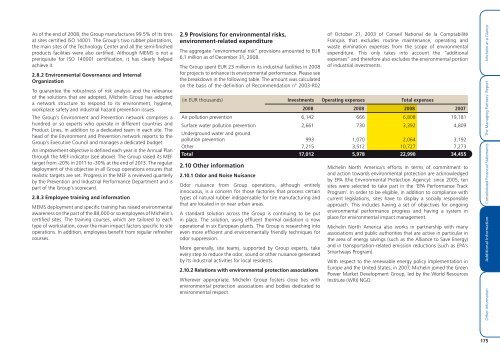MICHELIN - 2008 ANNUAL REPORT
MICHELIN - 2008 ANNUAL REPORT
MICHELIN - 2008 ANNUAL REPORT
Create successful ePaper yourself
Turn your PDF publications into a flip-book with our unique Google optimized e-Paper software.
As of the end of <strong>2008</strong>, the Group manufactures 99.5% of its tires<br />
at sites certified ISO 14001. The Group’s two rubber plantations,<br />
the main sites of the Technology Center and all the semi-finished<br />
products facilities were also certified. Although MEMS is not a<br />
preriquisite for ISO 140001 certification, it has clearly helped<br />
achieve it.<br />
2.8.2 Environmental Governance and Internal<br />
Organization<br />
To guarantee the robustness of risk analysis and the relevance<br />
of the solutions that are adopted, Michelin Group has adopted<br />
a network structure to respond to its environment, hygiene,<br />
workplace safety and industrial hazard prevention issues.<br />
The Group’s Environment and Prevention network comprises a<br />
hundred or so experts who operate in different countries and<br />
Product Lines, in addition to a dedicated team in each site. The<br />
head of the Environment and Prevention network reports to the<br />
Group’s Executive Council and manages a dedicated budget.<br />
An improvement objective is defined each year in the Annual Plan<br />
through the MEF indicator (see above). The Group raised its MEF<br />
target from -20% in 2011 to -30% at the end of 2013. The regular<br />
deployment of this objective in all Group operations ensures that<br />
realistic targets are set. Progress in the MEF is reviewed quarterly<br />
by the Prevention and Industrial Performance Department and is<br />
part of the Group’s scorecard.<br />
2.8.3 Employee training and information<br />
MEMS deployment and specific training has raised environmental<br />
awareness on the part of the 88,000 or so employees of Michelin’s<br />
certified sites. The training courses, which are tailored to each<br />
type of workstation, cover the main impact factors specific to site<br />
operations. In addition, employees benefit from regular refresher<br />
courses.<br />
2.9 Provisions for environmental risks,<br />
environment-related expenditure<br />
The aggregate “environmental risk” provisions amounted to EUR<br />
6.1 million as of December 31, <strong>2008</strong>.<br />
The Group spent EUR 23 million in its industrial facilities in <strong>2008</strong><br />
for projects to enhance its environmental performance. Please see<br />
the breakdown in the following table. The amount was calculated<br />
on the basis of the definition of Recommendation n° 2003-R02<br />
of October 21, 2003 of Conseil National de la Comptabilité<br />
Français that excludes routine maintenance, operating and<br />
waste elimination expenses from the scope of environmental<br />
expenditure. This only takes into account the “additional<br />
expenses” and therefore also excludes the environmental portion<br />
of industrial investments.<br />
(in EUR thousands) Investments Operating expenses Total expenses<br />
<strong>2008</strong> <strong>2008</strong> <strong>2008</strong> 2007<br />
Air pollution prevention 6,142 666 6,808 19,181<br />
Surface water pollution prevention 2,661 730 3,392 4,809<br />
Underground water and ground<br />
pollution prevention 993 1,070 2,064 3,192<br />
Other 7,215 3,512 10,727 7,273<br />
Total 17,012 5,978 22,990 34,455<br />
2.10 Other information<br />
2.10.1 Odor and Noise Nuisance<br />
Odor nuisance from Group operations, although entirely<br />
innocuous, is a concern for those factories that process certain<br />
types of natural rubber indispensable for tire manufacturing and<br />
that are located in or near urban areas.<br />
A standard solution across the Group is continuing to be put<br />
in place. The solution, using effluent thermal oxidation is now<br />
operational in six European plants. The Group is researching into<br />
even more efficient and environmentally friendly techniques for<br />
odor suppression.<br />
More generally, site teams, supported by Group experts, take<br />
every step to reduce the odor, sound or other nuisance generated<br />
by its industrial activities for local residents.<br />
2.10.2 Relations with environmental protection associations<br />
Wherever appropriate, Michelin Group fosters close ties with<br />
environmental protection associations and bodies dedicated to<br />
environmental respect.<br />
Michelin North America’s efforts in terms of commitment to<br />
and action towards environmental protection are acknowledged<br />
by EPA (the Environmental Protection Agency): since 2005, ten<br />
sites were selected to take part in the ‘EPA Performance Track<br />
Program’. In order to be eligible, in addition to compliance with<br />
current legislations, sites have to display a socially responsible<br />
approach. This includes having a set of objectives for ongoing<br />
environmental performance progress and having a system in<br />
place for environmental impact management.<br />
Michelin North America also works in partnership with many<br />
associations and public authorities that are active in particular in<br />
the area of energy savings (such as the Alliance to Save Energy)<br />
and in transportation-related emission reductions (such as EPA’s<br />
Smartways Program).<br />
With respect to the renewable energy policy implementation in<br />
Europe and the United States, in 2007, Michelin joined the Green<br />
Power Market Development Group, led by the World Resources<br />
Institute (WRI) NGO.<br />
Other Information<br />
Additional Information Consolidated Financial Statements The Managing Partners’ Report Michelin at a Glance<br />
175

















